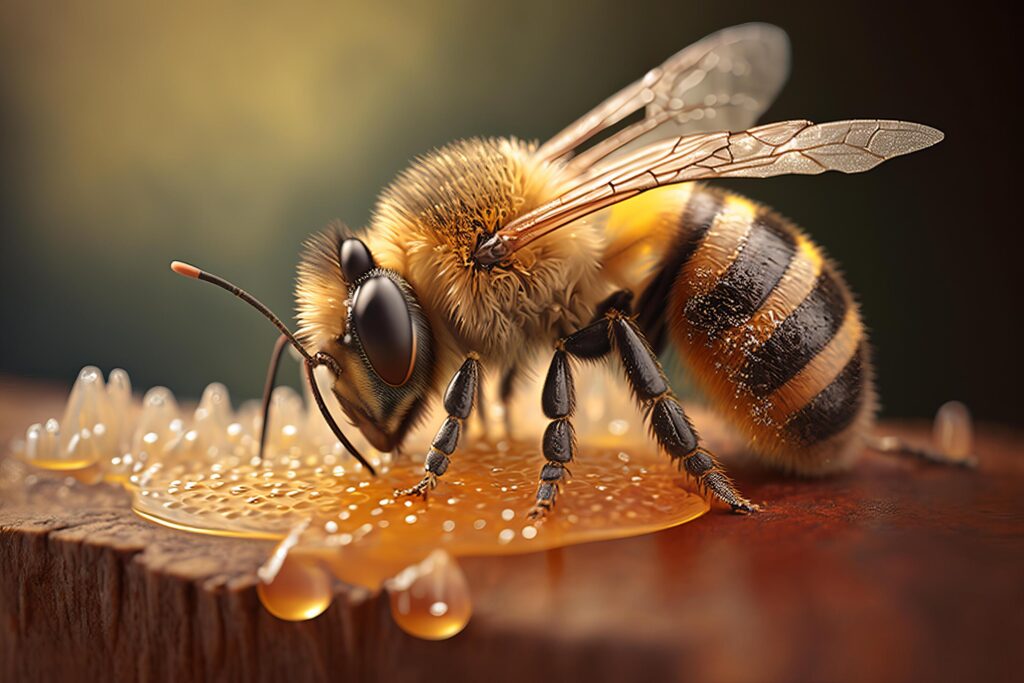5 Eyes of Honey Bees

Eyes of Honey BEEs
The Incredible Eyes of Honey Bees: Nature’s Complex Vision System
Honey bees (Apis mellifera), often admired for their role in pollination and honey production, possess one of the most fascinating visual systems in the insect world. Their eyes are perfectly adapted to help them navigate complex environments, identify flowers, and communicate with hive mates — all crucial for the survival of the colony.
Structure of Honey Bee Eyes
Honey bees have five eyes:
- Two large compound eyes on the sides of their head
- Three small ocelli (simple eyes) arranged in a triangle on the top of the head.
Each eye serves a different purpose, contributing to the bee’s exceptional vision capabilities.
Compound Eyes: The Main VisualForce
The two compound eyes are made up of thousands of tiny lenses called ommatidia. Each eye has about 6,900 ommatidia in worker bees, while drones (male bees) can have over 8,000, since they rely more on vision to locate queens during flight.
Key Features:
- Wide-angle view: Allows bees to detect movement quickly
- Color perception: Bees can see ultraviolet light, which is invisible to humans. This helps them identify flower patterns and nectar guides.
- Low resolution: Unlike human eyes, bee compound eyes are not very sharp, but they are excellent for spotting motion and general patterns.
Ocelli: The Light Detectors
The three simple eyes or ocelli are not for forming images but are sensitive to light intensity. They help bees:
- Stabilize their flight
- Navigate based on sunlight
- Adjust to changing light conditions quickly

Vision Capabilities
- Color Vision: Honey bees can perceive a range of colors from ultraviolet to green (UV, blue, green), but they cannot see red. This unique vision helps them detect flower colors and patterns invisible to us.
- Polarized Light Detection: Bees can detect the polarization of sunlight, helping them navigate even on cloudy days using patterns in the sky.
- Fast Visual Processing: Honey bees have high flicker-fusion rates, meaning they can perceive fast movements that are too quick for the human eye — essential for flying at high speeds through dense environments.
- Memory and Learning: Bees can remember landmarks, learn shapes, and even associate colors with rewards, showcasing their visual memory’s strength.
Differences Between Castes
- Workers: Balanced vision for foraging and hive work.
- Drones: Extra-large eyes for spotting queens during mating flights.
- Queens: Smaller, less developed eyes — they rely more on their sense of smell.
Fun Facts
- Bees recognize faces in a similar way humans do — by analyzing the configuration of features.
- Honey bees use a “waggle dance” to communicate the location of food sources, and their visual system helps them interpret and follow these dances.
- Flowers often reflect ultraviolet light, creating patterns that guide bees to nectar.
Conclusion
The eyes of honey bees are a masterclass in evolutionary design — specialized, multifaceted, and deeply tuned to the tasks that matter most for survival. Through compound eyes and simple ocelli, bees experience a world full of UV colors and motion cues, enabling them to perform complex tasks like foraging, navigation, and communication with astounding efficiency.



